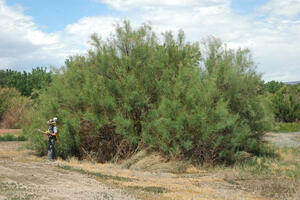Saltcedar
Saltcedar Tamarix spp.
Where does saltcedar come from?
- Saltcedar is a Eurasian native that was introduced into North America in the early 1800s.
- Saltcedar was imported as an ornamental, use for wind breaks, or for erosion control.
First collected in 1929, Saltcedar can now be found in 49 Kansas counties.
What does saltcedar look like?
- Saltcedar is a small tree or shrub that produces pink flowers May through October.
- The plant?s base is a branched clump with red/brown stems
- Saltcedar can often reach a height of 15-20 feet.
Why is saltcedar a problem?
- Saltcedar forms dense monocultures and dramatically changes vegetation structure and animal species diversity.
- Saltcedar accumulates salt in its tissues, which is later released into the soil, making it unsuitable for many native species.
- Large saltcedar plants can use up to 200 gallons of water a day thus reducing and even eliminating water flow.
- The leaves, twigs and seeds are extremely low in nutrients, and, as a result, very few insects or wildlife will use them.
How do we control saltcedar?
- Saltcedar is difficult to eradicate. It resprouts readily after cutting or burning. Research and many programs are now in place to learn how to reduce or eradicate saltcedar.
- Contact your local Kansas Department of Agriculture office for specific control techniques for an established population.
Images and Recent news
Saltcedar links:








